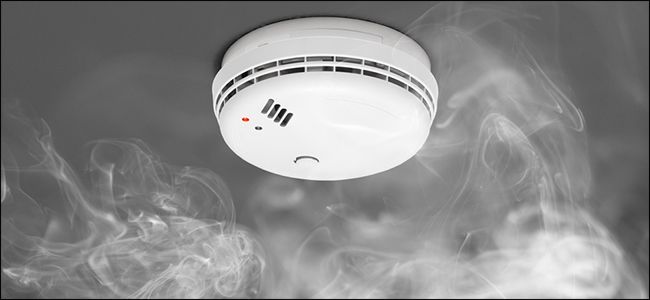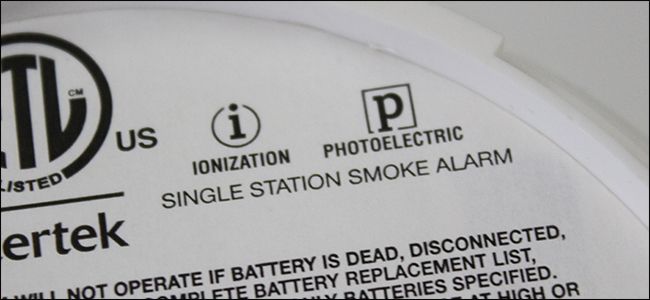Quick Links
Smoke alarms are cheap and pretty basic, but they can definitely be life savers. However, there might be some things you don't know about smoke alarms that could make you rethink the ones you have now.
Smoke Alarms vs. Smoke Detectors
Before we dive deep into discussing smoke alarms, it's important to talk about the differences between smoke alarms and smoke detectors. These two terms are colloquially interchanged, but they're actually different types of devices.
The big difference is that "Smoke alarms" are all-in-one self-contained units that include the smoke sensor and the audible alarm. This is likely what you have in your house or apartment.
"Smoke detectors" usually only contain the smoke sensor and nothing else. From there, the alarm is a separate unit and the controls for the whole system are kept in a central location. You'll find these types of systems in commercial applications, like in hotels and hospitals.
So basically, smoke alarms are what you would find in most residences, whereas smoke detectors are usually found in places of business. In this article, though, we'll be focusing mainly on residential smoke alarms.
There Are Two Different Types of Smoke Sensors
Unfortunately, not all smoke alarms are created equal. This is because two different types of sensors exist for detecting fire and smoke. Those two sensors are called "photoelectric" and "ionization" sensors, and they both sense vastly different types of smoke and fire.
In a nutshell, photoelectric sensors are good at sensing smoldering fires, which are slow-burning fires that don't produce much of a flame. Ionization fires are great at detecting the opposite---fast-burning fires that produce a lot of flames. Both sensors use different sensing technologies, thus the reason for detecting different types of fires.
You can absolutely find smoke alarms that offer both types of sensors in one device, but it's also pretty easy to find smoke alarms that only offer one or the other. If it wasn't obvious, it's recommended to buy a smoke alarm that comes with both types of sensors, like this model from First Alert.
If you're interested in a smart smoke alarm like the Nest Protect, it technically only includes a photoelectric sensor. However, it's noted that the sensor is "split-spectrum", which basically just means that it's highly sensitive to both types of fires.
Battery-Operated vs. Wired Smoke Alarms
On top of the different types of sensors, smoke alarms also come in two different types of power connectivity: battery-operated or hardwired into your home's electrical system.
Hardwired smoke alarms are arguably the best because not only do you not need to worry about changing the batteries, they're also interconnected. This means that if one alarm goes off, then all of the other alarms go too, which is great if you have a larger house and there's the possibility of not being able to hear one alarm go off from across the house.
Not all houses are wired for smoke alarms, though, which is where battery-operated units come into play. They're also easier to install, since there are no wires to deal with.
In any case, it's important to know which type your house uses so that you don't buy the wrong one when it comes time to replace them, which brings us to our next point..
Smoke Alarms Eventually Expire
Just like that milk sitting in your fridge, smoke alarms go bad after a while.
The National Fire Protection Association recommends that you replace your smoke alarms every ten years. This is because the sensors eventually degrade in quality to the point where they're no longer effective.
Yes, that even includes your more expensive smart smoke alarms. On top of the NFPA's recommendation for replacing smoke alarms, Nest says that most CO detectors need to be replaced every 5-7 years, and since the Nest Protect has a CO detector, you can plan on replacing the entire unit that often.
Where You Need to Install Smoke Alarms
It's likely that when you first equipped your home with smoke alarms, you just chose a couple spots around the house that seemed like good places to install them. However, you probably need more smoke alarms than you think.
According to the latest edition of the NFPA 72 National Fire Alarm and Signaling Code, you need to install smoke alarms inside every bedroom, outside every sleeping area (like a hallway that connects a bunch of rooms together), and on every level of the home, including the basement.
It's also important that you install them no farther than 12 inches from the ceiling if you're installing them on a wall (since smoke rises), as well as not installing them near doors, windows, or vents where drafts and general airflow could interfere with the smoke alarm's detection abilities.
Image from nikkytok/Shutterstock






